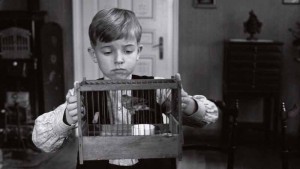Spoilers below, sort of.
Michael Haneke is probably one of my favorite working filmmakers, though I find him one of the most difficult to talk about precisely because terms like “favorite” seem slightly askew when discussing his work. To watch a Michael Haneke film is to implicate yourself in complex, nearly ineffable communities bound together by buried or unspoken acts violence and guilty complicity, and so the language of “pleasure” and personal gratification seems ill-suited to describe the experience of watching one. Can one say that one “enjoyed” Caché or Benny’s Video or (especially) Funny Games? Not quite. Plenty of reviewers, hostile and friendly, discuss Haneke’s themes, all of them bound up with postwar and postcolonial Europe as well as the violence of American mass culture, though few of them discuss the difficulty of discussing them.
 The White Ribbon is no different in the manner in which it baffles the language of personal reaction, and it’s perhaps Haneke’s best film to date. In terms of its construction, it’s certainly the most ingenious. It’s a marker of Haneke’s growth as a filmmaker that he’s grown so adept at turning away from the depiction of acts of violence and toward the enigma of their aftermath. The chilling thing about The White Ribbon, though, is that we know that the film’s violence is merely a prelude.
The White Ribbon is no different in the manner in which it baffles the language of personal reaction, and it’s perhaps Haneke’s best film to date. In terms of its construction, it’s certainly the most ingenious. It’s a marker of Haneke’s growth as a filmmaker that he’s grown so adept at turning away from the depiction of acts of violence and toward the enigma of their aftermath. The chilling thing about The White Ribbon, though, is that we know that the film’s violence is merely a prelude.
In his New York Times review, A.O. Scott writes:
Forget about Weimar inflation and the Treaty of Versailles and whatever else you may have learned in school: Nazism was caused by child abuse. Or maybe by the intrinsic sinfulness of human beings. “The White Ribbon†is a whodunit that offers a philosophically and aesthetically unsatisfying answer: everyone. Which is also to say: no one.
I don’t think this is quite right. To say that “everyone” is responsible is not to say “no one” is responsible; it’s to say everyone is responsible. One of the things the film does so well is question what we mean by “everyone” – Haneke seems to always take the term to its extreme. Everyone is everyone present, everyone who makes films about it, everyone who watches films about, everyone who knows about it. Hence, in the film’s climactic scene, the pastor’s anger when the school teacher tries to speak the truth about the acts of violence in the village. Silence both allows the perpetuation of violence and binds the community together; it’s a perpetually maintained blood oath.
I think that’s part of what makes talking about the experience of watching Haneke films so hard. In general, as good old T.W. Adorno noted in his speech “What Does Coming To Terms With The Past Mean?,” we’re not good at talking about collective guilt. In some way, any kind of emotional reaction to The White Ribbon implies a relationship to that guilt, and that’s not the kind of talk people usually want to have when they ask you how the movie was.
Recent Comments